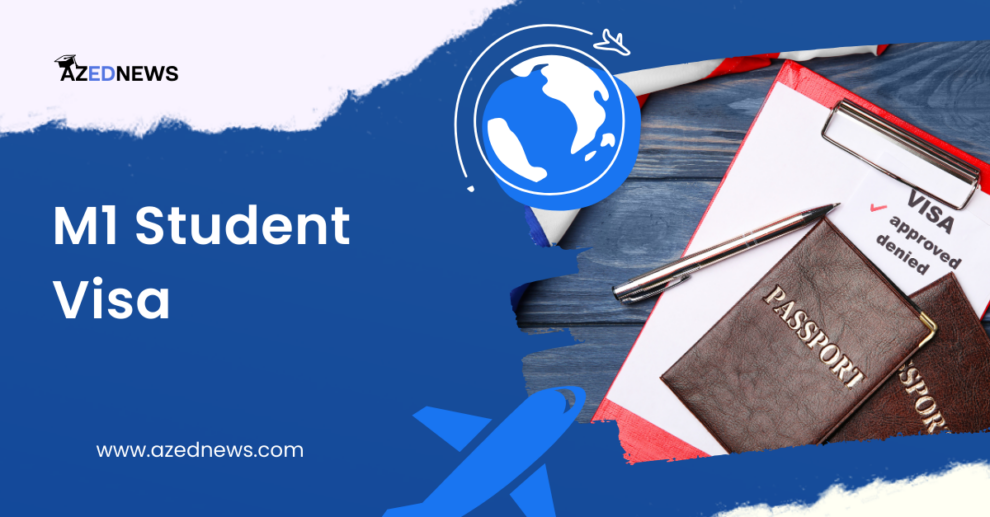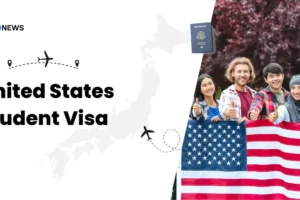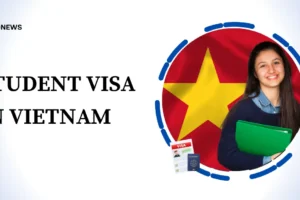Searching for information on M1 Student Visa? don’t worry we have covered a detailed article for you. Moving to the USA for education is something that most students dream of. The “M” visa is for students applying for non-academic or vocational studies. There are many courses that students can take to apply for an M1 visa.
Table of Contents
In this blog, we have covered all the important details related to M1 students visa which student can refer to pursue their M1 visa.
What is a M1 student visa?
The “M1” student visa is for nonacademic or vocational studies for students who wish to pursue a course in disciplines related to cooking, aviation, bakery, etc. M-1 visa holders for technical and vocational programs are not allowed to work in the United States while they are pursuing their studies. Moreover, the M-1 student visa applicants are required to produce evidence of sufficient funds that are immediately available to pay the tuition and living costs for the entire period of the intended stay.
The students are required to apply for the visa at least 12 months before their starting date. Once you have been approved to study for at least 12 semester or quarter hours at a community or junior college, post-secondary vocational school, or post-secondary business school, the US Department of State issues the visa.
What are the requirements for an M1 student visa?
Because there is no minimum quantity of permits issued every year, the students are required to meet the requirements to get their applications accepted. The various conditions of eligibility are:
- The student should be selected at a SEVP institution.
- The students are required to pay the entire cost of the program before the beginning of their studies.
- The students should have high English proficiency which is enough to permit them to get through with their vocational class. The students have to provide proof by taking standard English proficiency tests such as TOEFL and IELTS.
- The students are also required to have a non-immigrant intent which means that they are supposed to return to their residence country after the course is completed. To do so, students can prove strong family ties or evidence of a permanent foreign address.
- The student should be capable enough of sustaining themselves financially. To confirm the same, they would be expected to submit evidence such as bank account statements.
- A vocational institution authorised by the U.S. Citizenship and Immigration Services (USCIS) has accepted you for a complete course of study. A Form I-20 M-N, certificate of eligibility for nonimmigrant (M1) student status for vocational students, must be sent to you by the institution.
- Your intended education in the United States would be beneficial in your home country, which would encourage you to depart the country after your studies are finished.
How to apply for an M1 Student visa?
Once a student is enrolled in a SEVP-approved program, their data will be fed into the student and exchange visitor information system. For the student will be required the stipulated SEVIS I-901 fee. After registration with SEVIS, students can receive the I-20 which is also known as the certificate of eligibility for nonimmigrant student status which the student will have to bring for the visa interview.
Every university has a different admission policy. The university will ask the student as to what are the requirements that determine the academic eligibility of the student. Among others, students are also required to submit proof to school that they have enough financial stability to support themselves while studying without working. Moreover, students have to submit health insurance to cover any medical expenses in case of any need for medical assistance.
It is always advised to carry a copy of the documents students will be carrying for the interview.
Some steps to apply for an M1 visa at a local U.S. Embassy or consulate include:
1. Filling the application:
Every embassy has a varying set of rules that govern the M-1 visa application process, hence students are advised to thoroughly check the website of their local U.S. Embassy or consulate. For starters, students have to fill out form DS-160 which is also called an “Online Nonimmigrant Visa Application“, which will require the student to upload a photograph that meets the requirements laid out by the state’s departments. Print out the confirmation page when the process is completed.
Applicants must make an appointment for an interview at a U.S. Embassy or consulate in their home country unless they are under 13 or older than 80. Although it is technically possible, applying from another nation may lead to a somewhat drawn-out application process. Some things to remember are:
- There is an application fee that is not refundable that you must pay at the consulate in order to apply for your student visa. This implies that you won’t receive your money back in the event that your visa is denied.
- The online application for a non-immigrant visa, DS-160, must be filled out and submitted by all applicants.
- For all guys aged 16 to 45, a DS-157 form is mandatory.
- A passport that is good for travel to the US and has at least six months remaining on it after the time you plan to spend there. Every person who wants a visa, even if their passport lists more than one, needs to apply.
An image that is digital and can be uploaded are required to follow the following:
- Vibrant in hue
- Sized so that, from the bottom of the chin to the top of the head, the head occupies between 1 and 1 3/8 inches (22 and 35 mm), or 50% and 69% of the image’s overall height.
- Taken to represent your current appearance and taken during the last six months
- Captured on an off-white or plain white backdrop
- Captured with the face squarely in front of the camera.
- Both eyes open and wearing a neutral expression
- Taken while wearing what you would typically wear every day.
2. Preparing for the interview:
Most students will be required to pay an application fee of $160 prior to the interview. They should also get the following documents with them:
- A form I-20 which is signed by the applicant and an official from the respective study program. Additionally, the applicant’s spouse or any dependent should also apply for an I-20 form.
- The passport of the applicant should be valid for 6 months after the intended date of entry. Every family member would be required to apply on their own.
- A copy of the confirmation page of Form DS-160.
- A photograph that meets the requirements met by state departments.
- a receipt of the application fee.
3. Attending the interview:
During the interview, the consular officer will ask various questions that could potentially determine if the applicant qualifies for the M1 student visa. During the interview process, the officer might take digital fingerprints which does not always occur at every embassy. If the visa is approved, students may have to pay an insurance fee depending on the place of residence.
In a few cases, more administrative processing might be required. In such a situation, the officer will discuss plans to have your items returned to you.
While entering the United States, students will need to have their M1 visa, passport, and form I-20. Note that admittance into the nation is not guaranteed just because you have a visa. In the end, the U.S. Customs and Border Protection (CBP) agents get to make this judgement. The agent will stamp your passport or provide you with a Form I-94, also called an Arrival/Departure Record, if you are allowed entry.
Transferring schools with M1 Visa:
Transferring schools with M1 visa:
If a student starts a program in one school in the United States and requires a transfer to another program, they can apply for the same. However, it should be noted that M visa students can transfer only during their first 6 months of the program. After 6 months, if the student wishes to take a transfer, they are required to prove the following:
- They have maintained the nonimmigrant status for the last 6 months.
- They cannot continue their education at their current school owing to circumstances beyond their control.
- They are still capable of supporting themselves financially.
- They plan to be a full-time student at the new school they are transferring to.
Reasons for M1 student visa denial:
1. Country of origin:
The applicant’s nationality plays a huge role in visa approval and rejection. Applications from developed countries like Germany and Australia are usually accepted easily. However, applicants from third-world countries like Uzbekistan, Afghanistan, and India could face problems during their visa approval process.
2. Missing, incorrect, or suspicious documents:
Documents work as a huge piece of evidence that helps officials in gaining information regarding an applicant. Until the visa or immigration officials obtain all the required documents, the visa application does not get approved. Hence, it is very important that the students do not submit forged or duplicate documents and do not create a situation that causes suspicion.
3. Financial instability:
Financial instability is a huge problem during the visa selection process. US consulate officers expect the students to have sufficient funds to cover the expenses of their education. It is very crucial to present proofs that show the availability of funds.
4. An unsatisfied interview:
Since the M1 student visa interview lasts only for 2-3 minutes, the students are required to leave a long-lasting impression on the officials. The questions asked are quite general and could lead to potential refusal if the students cannot answer properly.
Tips for avoiding visa denial:
There are various ways students can increase their chances of getting a successful visa selection. Some tips are:
- Give the authorities enough time to evaluate your request by starting the visa application procedure well in advance. It is advisable to start the visa application process at least one month in advance of the dates you want to go.
- Verify that the application form is completed completely and accurately. To get rid of typos and missing or erroneous fields, you must carefully review your information.
- Ensure that all required paperwork is included, including an itinerary of your trip and proof of finances. Remember that your documentation should reflect the reason for your vacation, your connection to your home nation, and your plan to return after your trip.
- Tell the truth and be open about your motivations and ties to your nation of origin. The goal of the authorities is to confirm that you intend to come home after your trip.
- You might be required to attend a visa interview, depending on the situation. A comprehensive preparation and appropriate clothes are necessary for a successful interview. To ensure easy access to your documents on the day of your appointment, arrange them all neatly in one location. Answer all questions honestly, and provide your sources to back up your responses.
Frequently Asked Questions
1. What is the meaning of an M1 student visa?
With an M1 student visa, students can study full-time in various vocational, technical, and many other non-academic programs in the United States.
2. Can students work on an M1 visa?
No, students on M1 visas cannot work in the United States. However, they may apply for practical training after their education is done. If approved, students are permitted to have one month of training for every four months of studies they have completed.
3. How long is an M1 visa valid?
Students can stay in the USA for one year or until their program on an M1 visa is completed. They will also get an extra 30 days to prepare to leave the country.
4. What distinguishes an M1 student visa from an F-1 student visa?
The major reason that both F-1 and M-1 students travel to the United States is to finish a course of study that has been approved by the Student and Exchange Visitor Program (SEVP). M-1 students engage in vocational programs, whereas F-1 students enroll in more conventional academic programs.
5. Is getting an M1 visa easy?
You must demonstrate your ability to pay for your living and educational costs in the US in order to be granted an M1 visa. The estimated annual expenses listed on your I-20 form are your responsibility; thus, you must provide proof of your ability to pay that amount right away.
Conclusion
Officially, you need an M1 visa in order to study in the United States. Students may reapply but may no longer appeal after being rejected. If they adhere to the previously provided advice, they can simply escape rejection.
Although receiving a refusal for an M1 US student visa can be a frightening blow for aspiring overseas students, it’s not the end of the journey.
The first step in creating a stronger application is to become aware of the typical causes for denial, which include inadequate financial proof, a lack of ties to the home country, or a lack of preparation for the visa interview. Although there isn’t much of an appeals process for an M1 visa, students can still reapply and provide the reasons for denial in their new application.












Add Comment